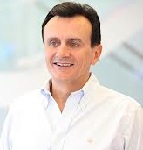 |
| AstraZeneca CEO Pascal Soriot |
AstraZeneca's ($AZN) closely watched blood thinner Brilinta came through for the drugmaker in the second quarter, as did its diabetes franchise, allowing the British company to pull off a 2% rise in sales (at constant exchange rates) to $6.3 billion and core operating profit of $1.8 billion, or $1.21 a share. Analysts surveyed by Bloomberg had been expecting the company to report a profit of $1.06 a share, and the surprise sent shares up 2% in pre-market trading on Thursday to $33.67.
Brilinta brought in $144 million in sales during the quarter--up 38% at constant exchange rates. Sales of Bydureon for treating Type 2 diabetes rose 29% to $140 million. Even some of AstraZeneca's older drugs performed better than expected, with generic competition not taking quite as big a bite out of sales growth as many feared it would. Sales of cholesterol fighter Crestor fell just 3% to $1.3 billion, while Nexium sales fell 27% to $647 million.
AstraZeneca has been on a deal spree of late, and as a result is benefiting from licensing revenue and other partnering-related proceeds, which the company now breaks out as a separate line item. During the quarter, licensing revenue increased 54% to $471 million, much of which came from a $450 million payment related to a deal the company struck with Celgene ($CELG), which will develop the immuno-oncology drug MEDI4736.
The company continues to look for external deals to boost to bring in additional cash. Earlier this week, Sanofi ($SNY) promised AstraZeneca $300 million for the right to develop Caprelsa to treat symptomatic medullary thyroid carcinoma.
AstraZeneca has been working hard to reprioritize its pipeline, focusing on cancer and other areas of high unmet medical need. There have been some bumps in the road, however. Last week, the company's cancer treatment selumetinib, which it is testing in melanoma of the eye, failed to improve progression-free survival in a late-stage trial.
As it works to shape up the pipeline, AstraZeneca continues to strive for improved efficiencies, though those efforts have yet to bear fruit. In a report, analyst Tim Anderson of Sanford Bernstein pointed out that AstraZeneca's better-than-expected earnings performance was helped by a one-time U.S. tax benefit. Cost control, he noted, was "just barely visible," as sales and administrative costs remained flat while R&D spending rose.
Still, CEO Pascal Soriot remains optimistic, so much so that the company raised its full-year sales forecast. It now expects revenues to decline by a low single-digit percentage, rather than the mid-single-digit percentage previously predicted. "The initiatives introduced to increase efficiency are starting to reduce SG&A costs, supporting our continued strategic investment in science and the acceleration of our pipeline which has positive momentum across all key areas," Soriot said in the earnings release.
- here's the earnings release
- read more at Bloomberg
- get the Wall Street Journal's take here (sub. req.)
Special Report: The top 15 pharma companies by 2014 revenue - AstraZeneca